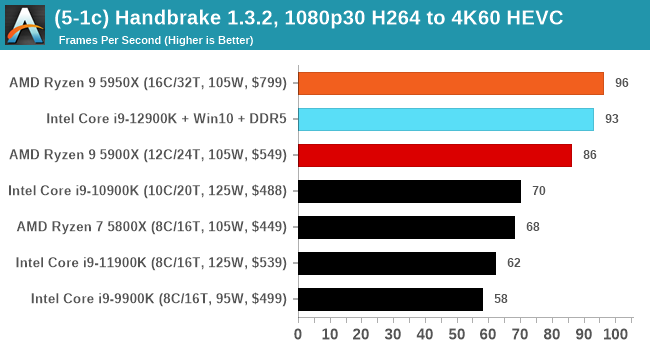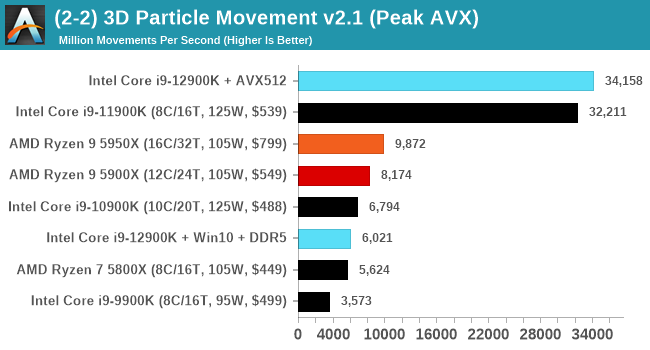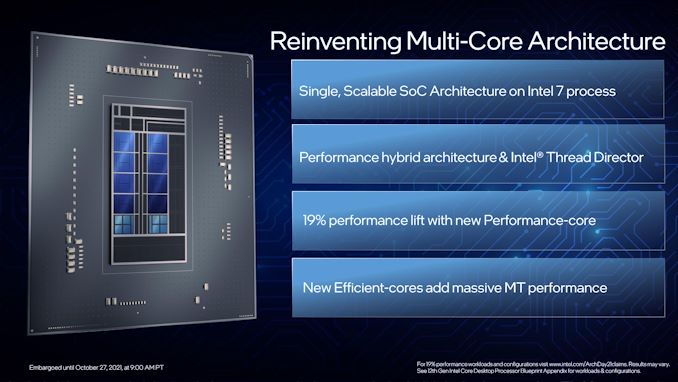The Intel 12th Gen Core i9-12900K Review: Hybrid Performance Brings Hybrid Complexity
by Dr. Ian Cutress & Andrei Frumusanu on November 4, 2021 9:00 AM ESTConclusion: Variables Maketh the CPU
Suffice to say, Intel’s new 12th Generation Core family has added more variables to the mix than a traditional processor launch. The combination of different types of core, coming at a time where a new operating system has just been launched, but also at the inflection point of a new type of memory. Let’s break down some of the differences we’ve observed in our testing.
When we compare Windows 10 to Windows 11, purely on throughput benchmarks, we don’t find much difference. There are a few spots where Windows 11 has a slight advantage in multi-threaded workloads, but this comes down to how new threads are spawned between the performance cores and the efficiency cores. Intel stated that the performance between the two, at least for CPU workloads, should be within a few percentage points, stating that Windows 11 should have lower run-to-run variance. We can corroborate this in our testing. Windows 10 also had some scheduling issues with low priority threads, which we expect to be ironed out with updates.
Comparing the new DDR5 to the old DDR4 is a different story, as the new memory standard offers a substantial uplift when it comes to memory bandwidth. As we saw recently with the M1 Max review, sometimes memory bandwidth can be a limiting factor. In our testing, DDR5 had a minor lead in single threaded tests but in a lot of multithreaded tests, the lead was significant. For real world, we had examples of +14% in Agisoft, +10% in NAMD, +8% in V-Ray, +10% in Handbrake, and +20% in WinRAR. In SPEC2017, we saw a couple of single threaded workloads get +15% improvements over DDR5, but in multi-threaded this was up to +40% on average, or more than 40% in specific tests. This also comes down to the doubled memory channels (4x32-bit vs 2x64-bit) which can be better utilized on top of the bandwidth increases.
Now comparing the P-core to the E-core, and it’s a story of how the E-core individually can perform on par with a Skylake core. Having eight extra Skylake-class cores is nothing to be sniffed at. In a lot of tests the E-core is half the performance of the P-core, but the P-core is itself is now the market leader in performance. The Golden Cove core inside Alder Lake has reclaimed the single-threaded performance crown with an uplift in SPEC of 18-20%, which is in line with Intel’s 19% claim. This puts it ahead of Apple’s M1 Max or 6% (int) and 16% (fp) ahead of AMD’s Zen 3 core.
The Core i9-12900K
Combining fast P-cores, Skylake-class E-cores, and DDR5 into one package means that Intel has certainly jumped from behind the competition to in front of it, or at least in the mix. When you have your operating system set up just right, and no issues with schedulers, it outperforms AMD’s offering when single core performance matters, and in multi-threaded workloads, it does tend to sit somewhere between a 5900X and a 5950X.

It’s important to note that in some tests, the Core i9-12900K does win outright. It’s at this point we should consider how much is core related vs standards related: DDR5 has produced somewhat of an uplift, and the competition is expected to claw some of that back when they introduce it, but those products are expected more towards the latter half of 2022. For users with those specific workloads today, and willing to pay the DDR5 early adopter tax, Alder Lake can provide performance uplifts right now.

Power is an interesting topic, and although our peak power numbers when all cores were loaded were above the 241W Turbo power on the box, in real world workloads it didn’t tend to go that high. The P-cores alone on the chip matched the power consumption of Intel’s 11th Generation in AVX2 workloads, but adding in the E-cores does put it over the previous generation. I’m not entirely sure what that says about Intel’s 7 manufacturing process compared to the 10SF used before. A lot of the performance gains here appear to come from IPC and DDR5, and that doesn’t seem to have come with performance per watt gains on the P-cores. It means that Intel is still losing on power efficiency at load compared to the competition.

I have to say a side word about AVX-512 support, because we found it. If you’re prepared to disable the E-cores, and use specific motherboards, it works. After Intel spent time saying it was fused off, we dug into the story and found it still works for those that need it. It’s going to be interesting to hear how this feature will be discussed by Intel in future.
Overall though, it’s no denying that Intel is now in the thick of it, or if I were to argue, the market leader. The nuances of the hybrid architecture are still nascent, so it will take time to discover where benefits will come, especially when we get to the laptop variants of Alder Lake. At a retail price of around $650, the Core i9-12900K ends up being competitive between the two Ryzen 9 processors, each with their good points. The only serious downside for Intel though is cost of switching to DDR5, and users learning Windows 11. That’s not necessarily on Intel, but it’s a few more hoops than we regularly jump through.











474 Comments
View All Comments
ajollylife - Sunday, November 7, 2021 - link
I agree. I've got a 3995wx everything on qvl, even with an optane drive. Got too annoyed with the bugs and found a 5950x worked better for a high performance desktop. Going to swap to a 12900k once i can find parts.TheJian - Sunday, November 7, 2021 - link
If you know how to use mem timings, you idiots that depend on SPD's wouldn't have these problems (that covers about 90% of this crap, and knowing other bios settings solves almost anything else besides REAL failures). I've been building systems for decades (and owned a PC biz for 8yrs myself) and a MB's QVL list was barely used by anyone I know (perhaps to look up some ODD part but otherwise...Just not enough covered at launch etc). If I waited for my fav stuff to be included in each list I'd never build. Just buy top parts and you don't worry much about this crap.That said, if my job was on the line, I'd check the list, but not because I was worried about ever being wrong...LOL. I just don't have a liars face. I'd be laughing about how stupid I think it is after so many builds and seeing so many "incompatible memory" fixed in seconds in the hands of someone not afraid to disable the SPD and get to work (or hook up with a strap before blowing gigs of modules, nics repeatedly etc). Even mixing modules means nothing then (again, maybe if I was pitching servers...DUH....1 error can be millions) after just trying to make issues exists with mixing/matching but with timings CORRECT. No, they will work, if set correct barring some REAL electrical issue (like a PSU model from brand X frying a particular model mboard - say dozens in a weekend, a few myself!).
Too many DIY people out that that really have no business building a PC. No idea what ESD is (no just because it took a hit and still works doesn't mean it isn't damaged), A+ what?? Training? Pfft, it's just some screws and slots...Whatever...Said the guy with machine after machine that have never quite worked right...LOL. If you live in SF or some wet joint OK (leo leporte etc? still around), otherwise, just buy a dell/hp and call it a day. They exist because most of you are incapable of doing the job correctly, or god forbid troubleshooting ANYTHING that doesn't just WORK OOB.
Qasar - Sunday, November 7, 2021 - link
blah blah blah blah blahMidland_Dog - Saturday, November 27, 2021 - link
people like you cost amd salessilly amdumb
cyberpunx_r_ded - Friday, November 5, 2021 - link
sounds like a Mobo problem, not a CPU problem....for someone who has put together "hundreds of systems" you should know that by the symptoms.That motherboard is known to be dog sh1t btw.
DominionSeraph - Saturday, November 6, 2021 - link
Note Intel doesn't allow "dog sh1t motherboards" to happen, especially at the $300+ price point. That makes it an AMD issue.I can refurb Dell after Dell after Dell after Dell, all of them on low-end chipsets and still on the release BIOS, and they all work fabulously.
Meanwhile two years into x570 and AMD is still working on getting USB working right.
I think I'll put this thing on the market and see if I can recoup the better part of an i9 12900k build. I may have to drop down to one of the i7 6700's or the i7 4770k system I have until they're in stock, but that's really no issue.
Netmsm - Saturday, November 6, 2021 - link
It's a pleasure to not have p*gheaded amateurs in the AMD zone.Others are telling you it's not AMD issue but you spamming it's AMD, AMD, AMD... having got the wrong and of the stick.
Wrs - Saturday, November 6, 2021 - link
@Netmsm Regardless of whether the blame lies with ASRock for the above issue, it remains a fact that AMD didn't fix a USB connectivity problem in Zen 3 until 6-7 months after initial availability. Partly that was because the installed base of guinea pigs was constricted by limited product, but it goes to show that quick and widespread product rollouts have a better chance of ironing out the kinks. (Source if you've been under a rock heh https://www.anandtech.com/show/16554/amd-set-to-ro...And then recently we had Windows 11 performance regressions with Zen 3 cache and sandboxed security. These user experience hiccups suggest one company perceptibly lags the other in platform support. It's just something I've noticed switching between Intel and AMD. I might think this all to be normal were I loyal to one platform.
Netmsm - Sunday, November 7, 2021 - link
I didn't realize we're here to discuss minor issues/incompatibilities of the Intel's rival. I thought we're here to talk about major inefficiencies besides improvements of Intel's new architecture. Sorry!Wrs - Sunday, November 7, 2021 - link
@Netmsm That's no minor issue/incompatibility. Maybe for you, but a USB dropout is not trivial! Think missing keystrokes, stuttering audio for USB headsets and capture cards. It didn't affect every user, and was intermittent, which was part of the difficulty. I put off a Ryzen 5000 purchase for 2 months waiting for them to fix it. (I also put it off for 4 months before that because of lack of stock lol.)